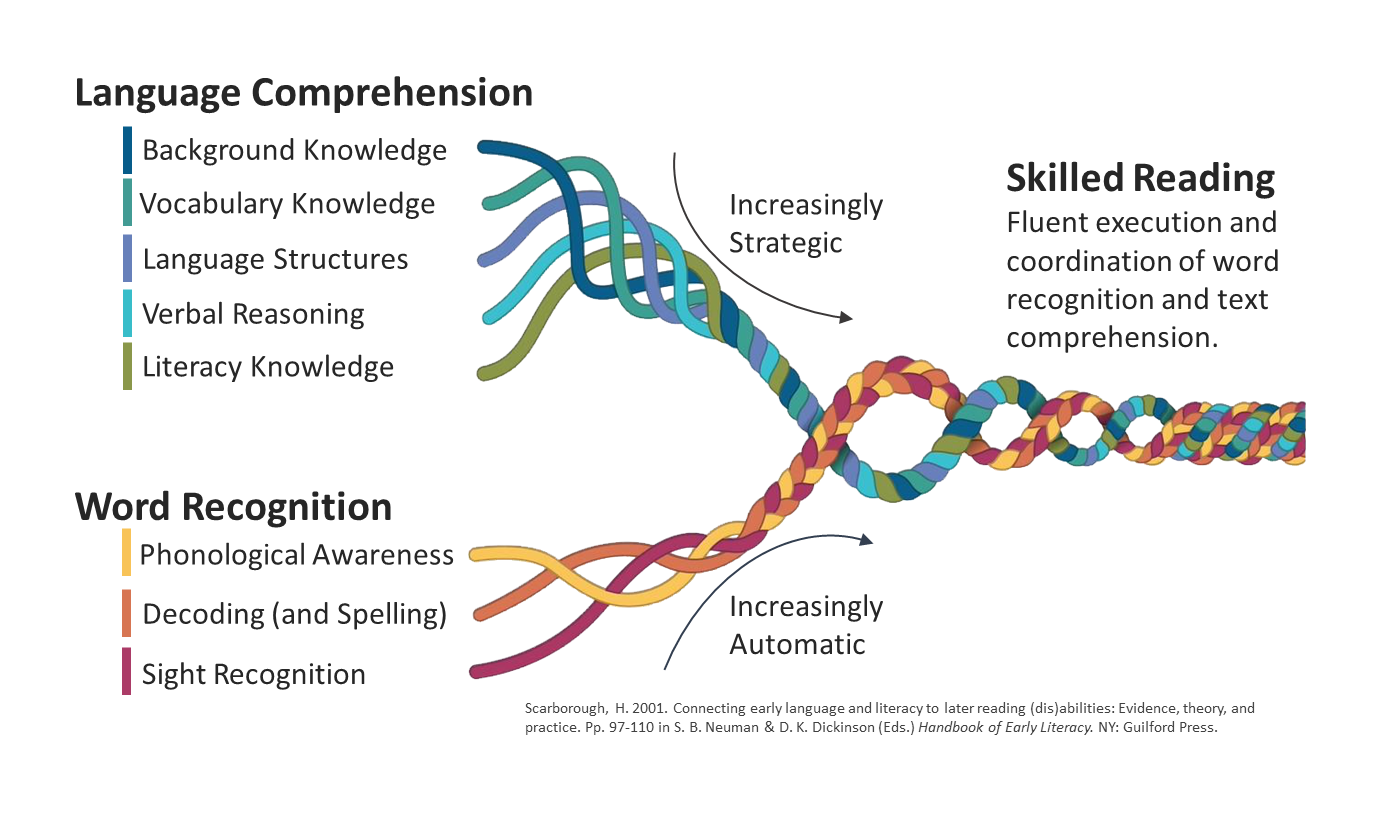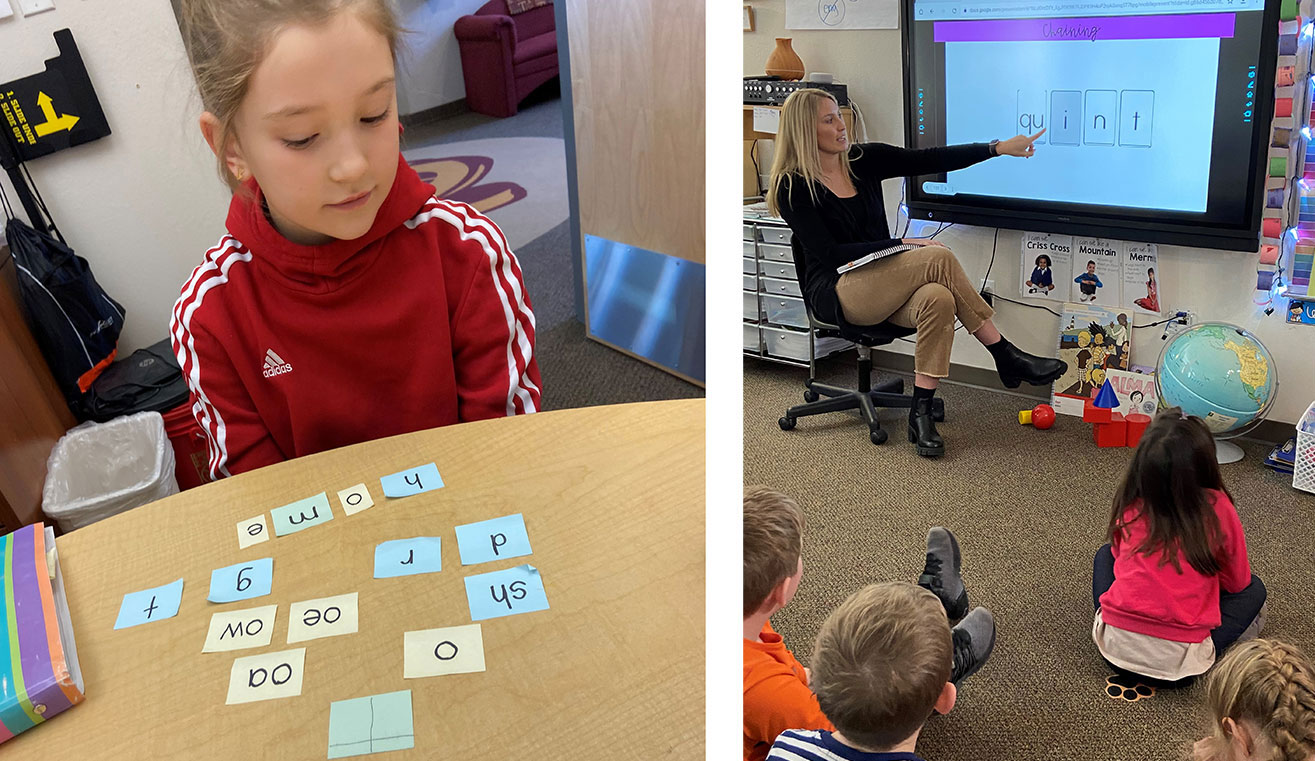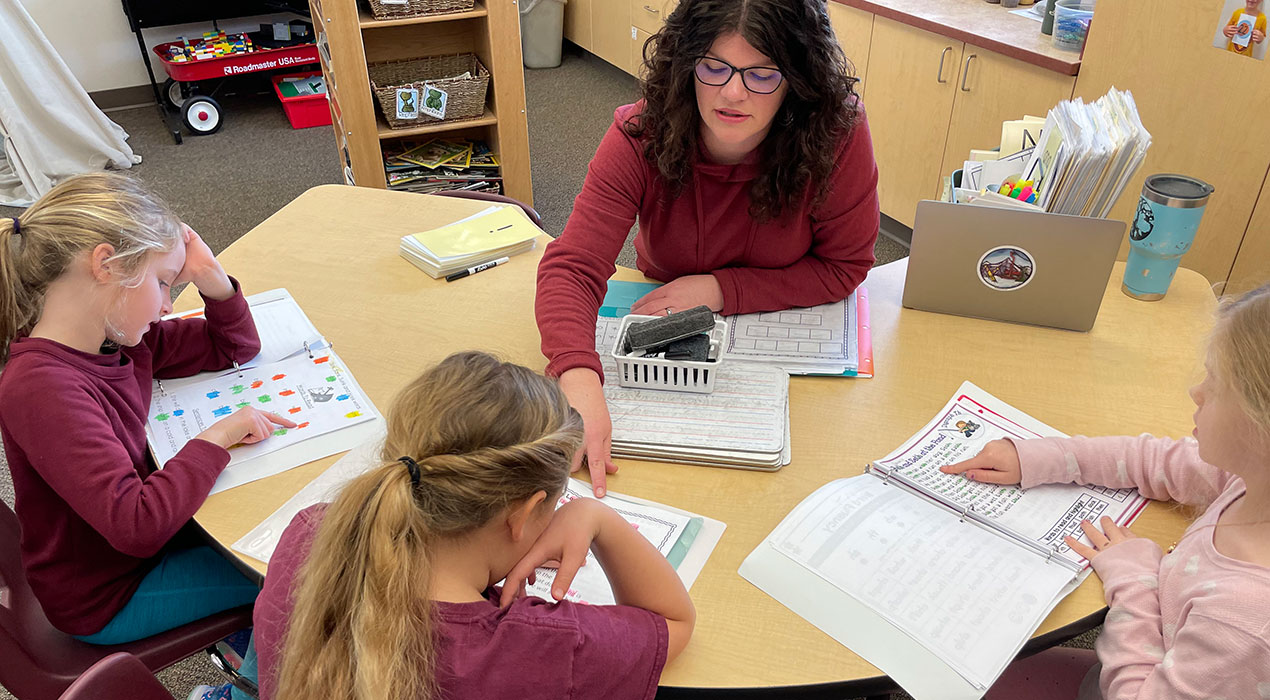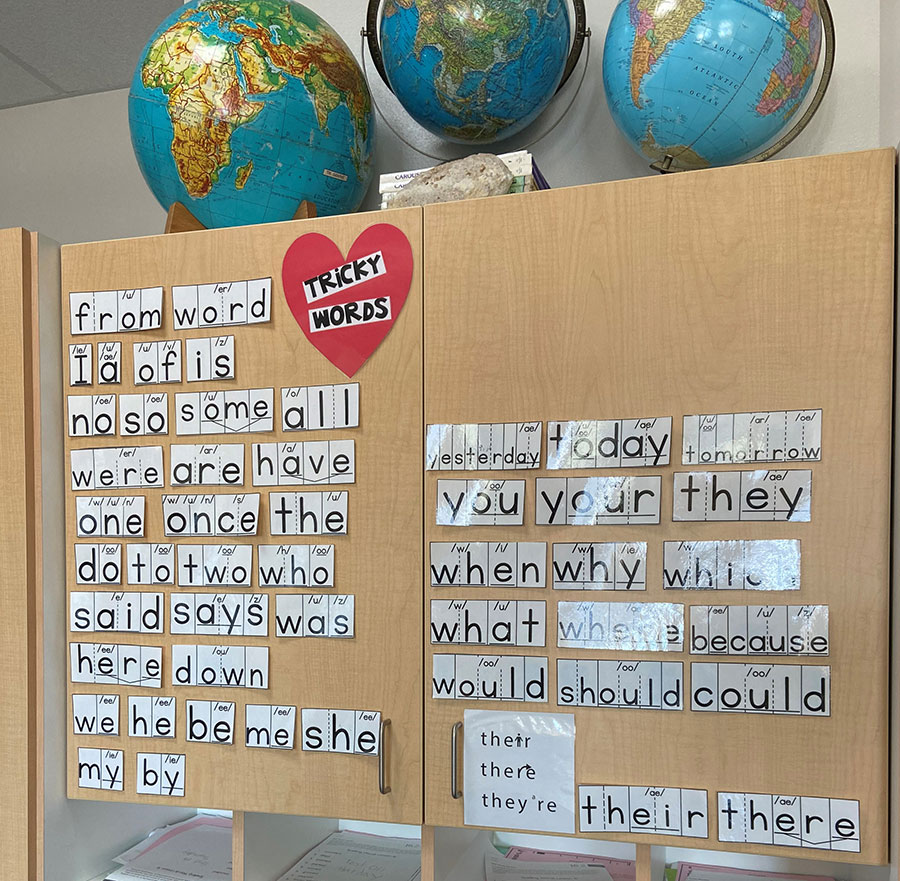During a recent Pizza with the Principal lunch, the group of kids attending that week — one from each grade, kindergarten through fifth — wanted to talk about the books they were reading. One student brought up what her class was reading about the Revolutionary War. Another student chimed in with a fact about the boats that crossed the Delaware River. They asked each other about favorite characters, best and worst parts in the stories, surprises and plot twists. One student even said that the day before he got to play George Washington on the playground when he and his friends were pretending.
“We could talk about a lot of other things during Pizza with the Principal, but here they were talking about books. And that just delighted me because I could see plain as day that they love reading,” says Big Horn Elementary School (BHE) Principal Kathy Powers.
Three years ago, before BHE transitioned to teaching reading using a structured literacy approach, Ms. Powers says she could not have imagined such a lively lunchtime conversation around that picnic-style gingham tablecloth.
Why Big Horn Elementary transitioned completely to structured literacy
Around 2016-2017, during their weekly professional learning community meetings — or PLCs, staff at BHE started asking more intentional questions about their data. They knew they had fantastic, devoted teachers. They knew they had a supportive administration. And they knew that their numbers around reading proficiency ranked above both state and national averages, and yet, only 65 percent of their students were proficient readers. Why?
“No matter what we did, we could not budge that meter,” says Ms. Powers. “That’s when we knew we had to do something drastically different.
BHE Literacy Coach Crystal Lenhart’s change in role from kindergarten teacher to reading specialist coincided with the state of Wyoming passing certain dyslexia legislation. “I was really motivated to dig into what type of instruction we needed for our students with dyslexia and discovered that structured literacy was it — not just for kids who struggle with reading but also for the benefit of all readers,” she says. “And then right around the same time, Emily Hanford started her podcast, “At a Loss for Words .” In the podcast, Ms. Hanford investigates the widespread flaws in reading instruction and helped spark a movement to bring the science of reading to schools. “So, the timing was perfect to broach with my colleagues the science of reading and the benefits of the structured literacy model and how it might help us boost our proficiency numbers and help more kids become successful readers.”
Ms. Powers adds, “We listened to the “At a Loss for Words” podcast as a staff. We immersed ourselves in articles, podcasts, videos, and the research itself. We delved into brain science and learned what processes in the brain need to take place for someone to actually learn to read. During our weekly PLCs, we reviewed our data with a fine-tooth comb and the research kept showing us again and again why the way we were teaching — with the Balanced Literacy approach — was not working across the board.”
“It took several months for us to educate ourselves, to take the time to ask all the questions that needed asking — and more, and to analyze deeply our core reading,” adds Ms. Powers.
“We were in disbelief, at first. How could we have been teaching kids to read in a way that was not working for so long? How could we have let so many students pass onto middle school and know we could have better helped them? That disbelief turned to a sort of grief. But what motivated us to go all-in to transform how we teach reading was our vehement belief that every student deserves the opportunity to learn to read.”
— Kathy Powers
How Big Horn Elementary taught reading before they transitioned to structured literacy
There is nothing natural about learning to read. It does not just happen organically like learning to walk or talk. And there is certainly no magic involved. Learning to read is a process — a process that involves explicit, systematic, and sequential teaching of literacy at multiple levels — from phonemes, letter-sound relationships, and syllable patterns to morphemes, vocabulary, and sentence structure. Learning to read takes cumulative practice and ongoing review. A house does not get built without first building its foundation and structure. You cannot paint walls, hang shutters, or tile a kitchen floor without first building that strong foundation and structure.
So, like countless other schools across the country, why did BHE teach reading with the balanced literacy model for so long?
“For many of us, teaching the balanced literacy approach reaches as far back as college. I remember I had one class in college that was based on phonics. We learned a bit about phonics and phonological awareness, decoding, encoding, and morphology. One class in four years. The rest focused on guided reading and the three-cueing system,” says First-grade Teacher Caroline Houck who has been a teacher for 12 years. “Then when I came to Wyoming to start teaching, the schools used the Fountas and Pinnell Leveled Literacy Intervention curriculum and Jan Richardson’s guided reading books. That’s what schools everywhere were doing. Who questions the ‘experts’?
“As a first-grade teacher, I always taught some phonics — because obviously you have to teach your students that letters have sounds and how we put those sounds together. On average, we’d do about 15 minutes of phonics but when it came time for reading, the sounding-out-words part seemed to fall to wayside and we would focus on the three-cueing system. We were teaching how we were taught to teach,” says Ms. Houck.
“Coincidentally, around the same time that Crystal Lenhart at our school started to share the research she had been doing and we, as a school, started questioning our methods, a teacher friend from another state told me about Emily Hanford’s story, ‘Hard Words: Why Aren’t Kids Being Taught to Read? ’ I just remember reading it and thinking, this can’t be right. I can’t have been doing this all wrong for 10+ years. It took a while to sink in that we were not teaching kids how to crack the code; we were not systematically teaching them how to read actual words made up of actual sounds.”
“Along with my colleagues, I started to look at the research and the science behind it and realized that we had been doing this all wrong and that we had been fooled.”
— Caroline Houck
During their deep dive into the science of reading, staff at BHE did make sure they learned as much as they could about all reading theories, and took to heart advice like that of Emily Solari, PhD , who asserts, “It’s equally important that we do not follow a single researcher/guru/advocate. This goes for all sides of this “war,” including SOR advocates and ed gurus. Follow the evidence, not the people.”
“We went all-in!”
“Once we decided to fully change our approach to teaching reading, we jumped in with both feet. We were fortunate from the beginning of our transition to structured literacy because we had a partnership with a nonprofit in Wyoming called WY Lit , which helped us kick off our LETRS (Language Essentials for Teachers of Reading and Spelling) training,” explains Ms. Lenhart. “From there, we knew we needed to invest in high-quality instructional materials that lined up with the research because if you don’t have the resources to support your curriculum, you’re going to have one arm tied behind your back. So, we went all-in.”
“Our school is a learning school, and a relationship school. We listen to each other and invite truthful feedback. It’s okay to disagree, but collaboration — and change — only happen through trust and open conversation,” says Ms. Powers. “All of our teachers are here because they want our kids to learn. A silly analogy, maybe, but everyone at Big Horn is in the right seat on the same bus; that sense of ownership, buy-in, is essential in any learning institution. That fact alone is what made the full curricular transition to structured literacy work.”
Along with LETRS training, Big Horn, for its curriculum, uses Amplify CKLA for kindergarten through third grade and Wit and Wisdom for fourth and fifth grades.
“We very much wanted a knowledge-building curriculum where the skills kids were learning in reading overlapped and expanded into writing, vocabulary, and comprehension — and into other academic subjects like social studies and science,” says Ms. Lenhart. “All the skills strands are in there.”
Scarborough’s Reading Rope
The concept of the reading rope weaves together word recognition and language comprehension.

What reading instruction looks like now at Big Horn Elementary
So, what does a literacy block look like at Big Horn? Language arts/reading take place three different times each day, each with a different approach. Ms. Houck explains.

Skills: whole-group instruction
“First, we do skills for about an hour, which focuses on phonemic awareness using Heggerty , and explicit phonics instruction. This means that all K-2 students are focused on acquiring the skills to crack the code of our alphabet. During this time, students have a skills workbook to practice skills and to use for comprehension. They also have a decodable reader that is targeted to the specific patterns taught. I read the story first, then they partner read or read it on their own. Then they answer comprehension questions in their workbook. These activities are focused on decoding and encoding … reading and writing. This is whole group for all first graders; similar instruction would be in all K-2 classrooms. Third through fifth grade classrooms focus more on morphology, comprehension, and fluency.”
Walk to Reading: small-group instruction
“All K-5 classrooms also have Walk to Reading time, about 30 minutes. This is our small-group instruction and differentiation where students work at their level with a few other students. Our school has a specific scope and sequence that we follow for all students. We know that students learn at different rates, so this is where we can either go slowly or more quickly for students. Students progress through our phonic continuum as they master the skills.”

Photo: First-grade Teacher Caroline Houck working with three of her students during small-group instruction.
“A typical 30 minutes would focus on the following: Phonemic Awareness (we use David Kilpatrick’s Equipped for Reading Success , tricky word and “heart-word” instruction and practice, skills review and drill of past skills, the explicit phonics instruction for the day, word work for that phonics instruction (Elkonin boxes, chaining, word sorts, analogy charts, rhyme or pattern matches), sentence dictation with the specific phonic pattern taught, and then a decodable reader that also focuses on the pattern. Grades 3-5 focus more on grammar, morphology, fluency, writing, and comprehension. If there are students who have holes in their phonic continuum, this would be the time where we would fill those holes with explicit phonics instruction.”
“During Walk to Reading, we flood the grade levels that are not at specials with our K-5 language arts teachers as well as with some paraprofessionals, reading specialists, and special ed teachers. This model really helps get kids exactly what they need because we do a lot of diagnostic assessment and we can offer more intervention and repetition based on each student’s needs.”
— Crystal Lenhart
Knowledge building
“We also have a knowledge component that runs about 30-60 minutes, depending on the grade level. This is where teachers read rich read alouds about certain topics and we focus on vocabulary instruction and comprehension. We use writing and group discussion to extend these lessons. The units help our students build a broad knowledge base of history and social studies, science, and the arts. Research tells us that building knowledge and learning vocabulary contributes significantly to reading comprehension. This is all connected to a student’s background knowledge and is just one more piece to creating lifelong successful readers.”
Brains, libraries, and classroom walls
As part of their Life Skills classes, students learn about the different parts of the brain and how these different parts play a role in how a person learns to read. “We show kid-friendly videos of a sort of cartoon brain so they can visualize what is happening inside their own brains,” says Ms. Powers. “By showing these videos and explaining how the brain works to build neuro-connections, for example, we can also emphasize that we are all different and if some of us learn differently or struggle it’s not because we are not smart, it’s just that our brains are sometimes wired differently. But we are all smart, and we will all learn.
The transition to structured literacy also brought significant changes to school and classroom libraries and on the classroom walls. Ms. Powers explains. “It’s exciting to walk the halls at our school because there are tangible changes. On classroom walls, Word Walls with cueing images have transformed to Vowel Valleys and Tricky Word Walls — both all about sounds and how sounds come together into words. And our libraries are no longer delineated by reading levels but by genre and topic. If you are interested in dinosaurs or Greek mythology, you go right to a section to find all books about dinosaurs or Greek mythology.”

The library-by-topic rather than level has also helped with writing instruction. “In first grade, for example, we teach three different kinds of writing: informational writing, opinion writing, and personal narrative,” says Ms. Houck.
“Because of having more of a focus on decoding and encoding — and helping kids follow subject matter that excites them — students are having more success in writing, too.”
Ms. Lenhart adds: “Since we focused on transforming our reading instruction, we’re now looking more intentionally into enhancing our writing instruction through applying the self-regulated strategy development (SRD) writing method .”
Getting it right
“I think when a school gets literacy right, it changes the culture throughout the whole school, the whole community,” says Ms. Lenhart. “Teachers see the change, parents see the change, and each time a student sounds out a word and then another, their world expands.”
Related resources from Big Horn Elementary
- How We Teach Reading at Big Horn Elementary
- K-2 Reading Group Phonics Lesson Plan
- How We Approach Dyslexia at Big Horn Elementary
- K-3 Literacy Guidance Framework (Wyoming Department of Education)
